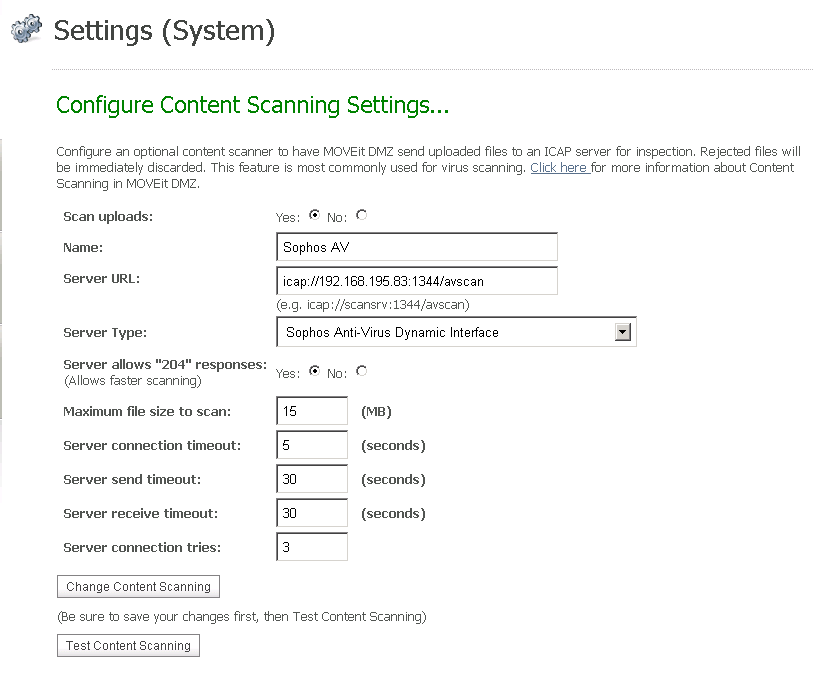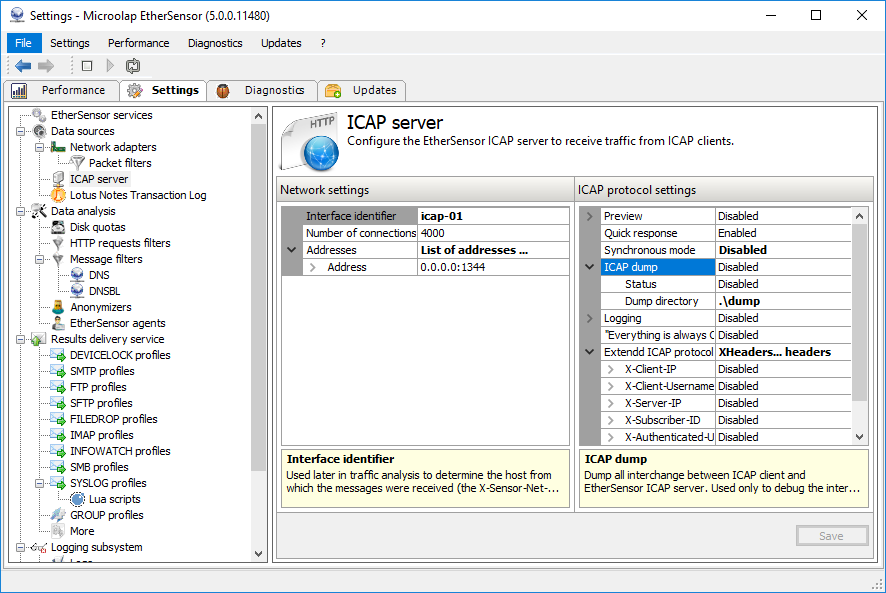
The Internet Content Adaptation Protocol ( ICAP) is a lightweight HTTP -like protocol specified in RFC 3507 which is used to extend transparent proxy servers, thereby freeing up resources and standardizing the way in which new features are implemented. ICAP is generally used to implement virus scanning and content filters in transparent HTTP proxy. I am using Squid3-dev with antivirus and SSL enabled. Works very well, but often it will give this error:ICAP is a light-weight response/request protocol that allows the FortiProxy unit to offload HTTP and HTTPS traffic to external servers for different kinds of processing.
Increasing MaxThreads parameter in clamd.conf may also help.ICAP Protocol Error, with a "no error" error codeThe following error was encountered while trying to retrieve the URL: This means that some aspect of the ICAP communication failed.An Illegal response was received from the ICAP server.The only way to fix it is to restart squid.I have read here: that changing some variables might help. I have doubled the default amounts described on the darold.net page, but it does not seem to help. Does anyone have any hints on what to look at next? This page also mentions that this works "with bypass enabled" - any idea what that means?The system returned: (60) Operation timed outThe remote host or network may be down.
The stunnel setup provides TLS encryption functionality to your data as it travels between your DLP server and Cloud App Security.This guide provides the steps necessary for configuring the ICAP connection in Cloud App Security and the stunnel setup to secure communication through it. To secure ICAP for transmission of your data, it's required to set up a secure TLS tunnel (stunnel) between your DLP solution and Cloud App Security. The platform exports easy-to-use interfaces including REST API and ICAP, enabling integration with content classification systems such as Symantec Data Loss Prevention (formerly Vontu Data Loss Prevention) or Forcepoint DLP.Integration is accomplished by using the standard ICAP protocol, an http-like protocol described in RFC 3507. Microsoft Cloud App Security can integrate with existing DLP solutions to extend these controls to the cloud while preserving a consistent and unified policy across on-premises and cloud activities. The enabled attribute of the AlwaysOk tag specifies whether the 'always ok' mode is active: enabled'true' - the mode is active.
The ICAP server and stunnel must be deployed together on the same network to make sure the traffic is encrypted. Deploying in other environments may result in degraded performance due to higher latency and lower throughput. However, other options including other Clouds and On-Premises deployment are supported. Responses are sent back to Cloud App Security over the stunnel where it's used by the policy to determine subsequent actions such as notifications, quarantine, and sharing control.Since Cloud App Security runs in Azure, a deployment in Azure yields improved performance. If external DLP scan is applied, the file is sent over the secure tunnel to the customer environment where it's relayed to the ICAP appliance for the DLP verdict: allowed/blocked.
Install stunnel on a server Destination TCP port: As defined in your networkWhile highly recommended, this step is optional and can be skipped on test workloads. Destination address(es): one or two IP address of the stunnel connected to the external ICAP server that you'll configure in the next steps Source addresses: Refer to Connect apps, under Prerequisites

key.pem with the name of your private key Or, on the stunnel server, use the following OpenSSL commands to generate a private key and a self-signed certificate. Then copy the keys to the server you prepared for the stunnel installation. Use your certificate management server to create an TLS certificate on your ICAP server.
Icap Protocol Error .Exe To Open
The DLP Server IP is the IP address of your ICAP server, stunnel-key is the key that you created in the previous step, and MCASCAfile is the public certificate of the Cloud App Security stunnel client. \cert.pem -days 1095Concatenate the cert.pem and key.pem and save them to the file: type cert.pem key.pem > stunnel-key.pemDownload the public key and save it in this location C:\Program Files (x86)\stunnel\config\MCASca.pem.Add the following rules to open the port in the Windows firewall: rem Open TCP Port 11344 inbound and outboundNetsh advfirewall firewall add rule name="Secure ICAP TCP Port 11344" dir=in action=allow protocol=TCP localport=11344Netsh advfirewall firewall add rule name="Secure ICAP TCP Port 11344" dir=out action=allow protocol=TCP localport=11344Run: c:\Program Files (x86)\stunnel\bin\stunnel.exe to open the stunnel application.Click Configuration and then Edit configuration.Open the file and paste the following server configuration lines. \bin\openssl.exe genrsa -out key.pem 2048.\bin\openssl.exe req -new -x509 -config ".\openssl.cnf" -key key.pem -out. By default it is:Run the command line with admin permissions. stunnel-key with the name of the newly created keyUnder your stunnel installation path, open the config directory.
Icap Protocol Error Update To Your
The DLP Server IP is the IP address of your ICAP server, stunnel-key is the key that you created in the previous step, and MCASCAfile is the public certificate of the Cloud App Security stunnel client: Cert = /etc/ssl/private/**stunnel-key**.pemCAfile = /etc/ssl/certs/**MCASCAfile**.pemUpdate your IP address table with the following route rule: iptables -I INPUT -p tcp -dport 11344 -j ACCEPTTo make the update to your IP table persistent, use the following commands: sudo apt-get install iptables-persistentSudo /sbin/iptables-save > /etc/iptables/rules.v4On your stunnel server, run the following command: vim /etc/default/stunnel4Change the variable ENABLED to 1: ENABLED=1Restart the service for the configuration to take effect: /etc/init.d/stunnel4 restartRun the following commands to verify that the stunnel is running properly: ps -A | grep stunnelAnd that it's listening on the port listed: netstat -anp | grep 11344Make sure that the network in which the stunnel server was deployed matches the network prerequisites as mentioned earlier. Or, on the stunnel server, use the following OpenSSL commands to generate a private key and a self-signed certificate.Key.pem with the name of your private keyCert.pem with the name of your certificateStunnel-key with the name of the newly created key openssl genrsa -out key.pem 2048Openssl req -new -x509 -key key.pem -out cert.pem -days 1095Cat key.pem cert.pem > /etc/ssl/private/stunnel-key.pemDownload the Cloud App Security stunnel client public keyDownload the public key from this location: /etc/ssl/certs/MCASCAfile.pem Configure stunnelThe stunnel configuration is set in the stunnel.conf file.Create the stunnel.conf file in the following directory: vim /etc/stunnel/stunnel.confOpen the file and paste the following server configuration lines. Also, set the permission on the files to readable for the stunnel owner and to none for everyone else.You can create the certificates in one of the following ways: You should get the version number and a list of configuration options:The ICAP server and Cloud App Security use a private key and public certificate for server encryption and authentication across the stunnel.Make sure you create the private key without a pass phrase so that stunnel can run as a background service. Run the following command on your Ubuntu server to install both stunnel and OpenSSL: apt-get updateVerify that stunnel is installed by running the following command from a console.



 0 kommentar(er)
0 kommentar(er)
